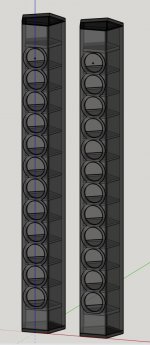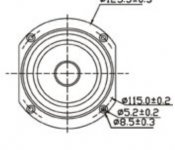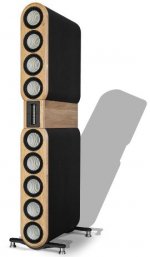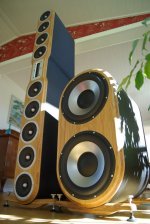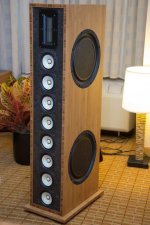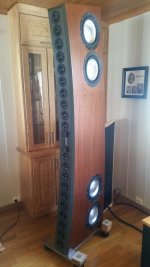well, a plan that has been in my head for more than a decade is finally moving into reality. what: a "semi-array" of a dozen of Tangband's bamboo W4-1320 that would sit nicely next to my HT's screen.
background: at a DIY meet-up in Breda (the famous "Luisterdag") I heard a simple line array with 25 of Visaton's FR8s. impressively large sound, perfect for cinema. Somewhat later I could (rather cheaply) get a hold of 2 dozen of the W4-1320 with the 'cut-off' basket, so they could be placed closer together.
Fast forward this year... next up is to start the woodwork. I'll be getting help from a pro with a cnc router for the difficult bits.
The intention is to keep it relatively simple, so no shading, just all 12 together (wired 4p-4p-4p) and then some corrections using the DSP.
background: at a DIY meet-up in Breda (the famous "Luisterdag") I heard a simple line array with 25 of Visaton's FR8s. impressively large sound, perfect for cinema. Somewhat later I could (rather cheaply) get a hold of 2 dozen of the W4-1320 with the 'cut-off' basket, so they could be placed closer together.
Fast forward this year... next up is to start the woodwork. I'll be getting help from a pro with a cnc router for the difficult bits.
The intention is to keep it relatively simple, so no shading, just all 12 together (wired 4p-4p-4p) and then some corrections using the DSP.
Attachments
Make sure your head in the listening position rests inside the line of 12.
The moment you move your head out, the highs will drop like a brick.
Also, 12 per line is not enough to give you low end, so you will need subs to support them.
Finally, you will need EQ. Probably more than the usual HT receiver can provide.
The moment you move your head out, the highs will drop like a brick.
Also, 12 per line is not enough to give you low end, so you will need subs to support them.
Finally, you will need EQ. Probably more than the usual HT receiver can provide.
yes, there will be a sub and a minidsp
I've experienced the drop in highs once, rather special. thanks for reminding
I've experienced the drop in highs once, rather special. thanks for reminding
Make sure your head in the listening position rests inside the line of 12.
The moment you move your head out, the highs will drop like a brick.
probably will need to tilt it a bit, some 11° should do to "aim" the centre of the line at my ears
i would place ribbon tweeter in the middle
just friendly advice
you can always disconnect it
but if you build speakers without it, hard to ad on later
just friendly advice
you can always disconnect it
but if you build speakers without it, hard to ad on later
probably will need to tilt it a bit, some 11° should do to "aim" the centre of the line at my ears
Your ears don’t need to be in the middle of the line, just between the top and bottom drivers of the line.
Adding a single tweeter might actually make it worse, being a point source in the middle of an array.
Well, the key word there is 'might' -it depends on the design. I wouldn't necessarily assume all those pictured are quality products. 😉 With a focused array, not so much of an issue, although that too will be affected by XO frequency & slope. Vertical? Potentially more so, again depending on XO frequency, since the Fresnel / Fraunhofer field is no longer equal, and typically arrays with a central tweeter will, a little like a focussed array (albeit not usually to quite the same extremes that the latter can have) tend to have an optimal listening distance. Jim also made this point about his old Needle TB + ribbon array -it's just a characteristic of the type. Which may, or may not be an issue, depending on what you're doing.
I could post tons of other line arrays with tweeter in the middle...just saying.
Was working on this recently. I finished the project, very happy with the results. I made some measurements, but did not have time to post it.
https://www.diyaudio.com/forums/multi-way/113262-foster-e100t10-ribbons-quality-2.html#post6611331
Was working on this recently. I finished the project, very happy with the results. I made some measurements, but did not have time to post it.
https://www.diyaudio.com/forums/multi-way/113262-foster-e100t10-ribbons-quality-2.html#post6611331
Absolutely -so could I for that matter, including several I've designed myself. As noted, the key word there was 'might', which to my way of thinking is not a synonym for 'all times, all places'. Since the laws of physics dictate it is a factor to consider when designing such systems though, it's worth keeping in mind & trying to account for it in the design stage. There's not a whole lot of use in designing an array like, say, Jim's Needles, which have a minimum listening distance, if that doesn't match the conditions. Same applies to any speaker of course. 😉
Last edited:
I do not know Jim's needles, never seen the design, never met the guy.
I do my own designs.
When a line array of small fullrange drivers suffer from severe beaming and comb filtering, the highs are compromised, and the system sounds dull, and if it can be fixed by one little tweeter, why not. The hell with theory, if it measures and sounds good with tweeter, why not. Not everyone here clearly agrees with that, I am fully ok with that too. Everyone has his own opinion. I do measure, and I listen.
Its up to the thread starter to build what he wants. I was just saying.
I do my own designs.
When a line array of small fullrange drivers suffer from severe beaming and comb filtering, the highs are compromised, and the system sounds dull, and if it can be fixed by one little tweeter, why not. The hell with theory, if it measures and sounds good with tweeter, why not. Not everyone here clearly agrees with that, I am fully ok with that too. Everyone has his own opinion. I do measure, and I listen.
Its up to the thread starter to build what he wants. I was just saying.
It's called an example. If you are allowed to give them, so am I. 😉
Nobody (I repeat for the second time) is saying 'you cannot [or do not] add a tweeter.' What is being pointed out is that it is not a panacea, and has a set of characteristics that need to be accounted for in the design stage. I don't honestly understand why you have such a problem with that being mentioned. 
A good proportion of wideband based arrays, once properly equalised (e.g. our own Wesayso's monsters) do not seem to suffer from dull HF, but there are plenty of valid alternatives as desired.
Nobody (I repeat for the second time) is saying 'you cannot [or do not] add a tweeter.' What is being pointed out is that it is not a panacea, and has a set of characteristics that need to be accounted for in the design stage

A good proportion of wideband based arrays, once properly equalised (e.g. our own Wesayso's monsters) do not seem to suffer from dull HF, but there are plenty of valid alternatives as desired.
@Henkjan in nc535's thread of his arrays he posted a Vituix model of a 25x TC9 array.
I believe this one (an older sim) was modeled with a floor mirror, you can remove that part and adjust the numbers and positions to fit your plans. This way you can play with the simulation and try a few options.
I've used it to find a fitting frequency dependent shading schematic for my own arrays. Not because I desperately needed it, just because I'm curious by nature. I've incorporated it into my arrays but haven't fired them up yet. I made it to be fully removable should it not bring any positives in practice. I do hope to be blown away though 😀. For me, it has been very educational to run the sims. Even though I had a lot of measurement data already. I can confirm that the sims get quite close to what's happening with arrays in a room.
A full model with floor and ceiling mirrors modeled as arrays can even predict what the measured impulse is going to look like (up to a point). Might be worth a try!
I believe this one (an older sim) was modeled with a floor mirror, you can remove that part and adjust the numbers and positions to fit your plans. This way you can play with the simulation and try a few options.
I've used it to find a fitting frequency dependent shading schematic for my own arrays. Not because I desperately needed it, just because I'm curious by nature. I've incorporated it into my arrays but haven't fired them up yet. I made it to be fully removable should it not bring any positives in practice. I do hope to be blown away though 😀. For me, it has been very educational to run the sims. Even though I had a lot of measurement data already. I can confirm that the sims get quite close to what's happening with arrays in a room.
A full model with floor and ceiling mirrors modeled as arrays can even predict what the measured impulse is going to look like (up to a point). Might be worth a try!
The reference to Jim's Needles is to my early design with a Aurum Cantus G3 ribbon tweeter arrayed between 16 TangBand W3-871 small woofers.
Some discussion and a photo in an old thread at:
Jim Griffin's Needles
Some discussion and a photo in an old thread at:
Jim Griffin's Needles
the line array's that I heard and liked (not that many I'll admit) were all straight arrays, no tweeter inserted, no shading. what attracted me (for HT use!) was the LARGE sound image they created. one had a tweeter array next to the mids-array. something like that would be plan B.
@wesayso I'll give it a go (only 130 pages to check) 😀 if I would consider shading, that would have an impact on the wiring and thus on the build.
@wesayso I'll give it a go (only 130 pages to check) 😀 if I would consider shading, that would have an impact on the wiring and thus on the build.
- Home
- Loudspeakers
- Full Range
- semi-array with W4-1320 (HT use)
